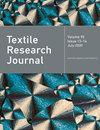利用织物悬垂性评估基于人工智能的新型纺织品数字化技术
IF 1.9
4区 工程技术
Q2 MATERIALS SCIENCE, TEXTILES
引用次数: 0
摘要
基于三维纺织品的服装原型制作在服装和纺织行业得到广泛应用,通过视觉原型制作提高了成本效益、工作效率和无缝沟通。基于神经网络的三维纺织品数字化技术无需进行传统的物理属性(PT)测量,因此具有简化制造流程的潜力。然而,关于该技术的准确性及其在高级功能性服装制造中的适用性还存在研究空白。主要的研究问题是调查从 PT 测量和基于人工智能(AI)的纺织品数字化中获得的数字化物理特性的变化如何影响织物机械表示的准确性。在这项研究中,我们旨在使用悬垂测试方法评估基于人工智能的纺织品数字化精度。悬垂系数(DC)分析表明,基于 PT 的模拟 DC 显示出 2% 至 11% 的归一化平均绝对误差(NMAE),而基于 AI 的模拟 DC 显示出 3% 至 51% 的误差范围。值得注意的是,除了那些非常柔软或非常硬的织物样本外,其他样本的基于人工智能的模拟显示出的归一化平均绝对误差在 3-15% 之间。本文章由计算机程序翻译,如有差异,请以英文原文为准。
Evaluation of a new artificial intelligence-based textile digitization using fabric drape
Three-dimensional (3D) textile-based garment prototyping, widely adopted in the apparel and textile industry, enhances cost efficiency, work productivity, and seamless communication via visual prototyping. Neural network-based 3D textile digitization has the potential to streamline manufacturing processes by negating the need for traditional physical property (PT) measurements. However, a research gap exists concerning the accuracy of the technology and its applicability to advanced functional apparel manufacturing. The primary research question is to investigate how variations in digitized physical properties obtained from PT measurements and artificial intelligence (AI)-based textile digitization impact the accuracy of a fabric’s mechanical representation. In this study, we aimed to evaluate AI-based textile digitization accuracy using a drape test method. The drape coefficient (DC) analysis revealed that the PT-based simulated DC exhibited a normalized mean absolute error (NMAE) ranging from 2% to 11%, while the AI-based simulated DC showed a range of 3–51%. Notably, for the samples, except those with very limp or very stiff fabric samples, the AI-based simulation exhibited a NMAE within 3–15%.
求助全文
通过发布文献求助,成功后即可免费获取论文全文。
去求助
来源期刊

Textile Research Journal
工程技术-材料科学:纺织
CiteScore
4.00
自引率
21.70%
发文量
309
审稿时长
1.5 months
期刊介绍:
The Textile Research Journal is the leading peer reviewed Journal for textile research. It is devoted to the dissemination of fundamental, theoretical and applied scientific knowledge in materials, chemistry, manufacture and system sciences related to fibers, fibrous assemblies and textiles. The Journal serves authors and subscribers worldwide, and it is selective in accepting contributions on the basis of merit, novelty and originality.
 求助内容:
求助内容: 应助结果提醒方式:
应助结果提醒方式:


